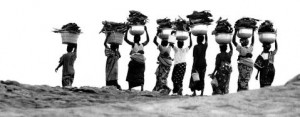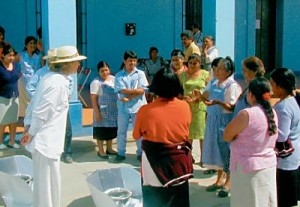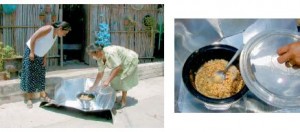
The HotPot in Mexico
Indeed, the general topic of solar energy has already been the subject of the DAAD Letter, which published a cover story, "Projekt Sonne", in March 1999. That article described a new partnership between a German university and one in northern Chile, where a Master’s program in renewable energy is now offered.
My interest in this promising technology has evolved from a life which has included many years spent living in developing countries in West Africa and Latin America, witnessing poverty and yearning to make a practical contribution to its alleviation. Some of my efforts have focused on organizing cooperatives to help African artisans sell crafts to western customers.

To improve the quality of life
More recently, in 1998, after developing a personal interest in solar cooking, I co-founded Solar Household Energy Inc. (SHE), a small non-profit organization (NGO) based in my home city of Washington, DC. Solar cooking is a very inexpensive and simple way to prepare food; adequate sunshine for solar cooking is available in 67 countries. Our mission is to harness free enterprise, to introduce solar cooking in the developing world in order to improve the quality of life and relieve stress on the environment. Our mission is very ambitious, but we believe great progress is possible.
Solar Household Energy Inc. recently won a small grant from the World Bank to introduce solar cooking in rural Mexico, working in a partnership with the Mexican Nature Conservation Fund (FMCN). In the Spring of 2003, I spent one month working on a challenging pilot project in the mountainous Sierra Gorda region of Mexico training village women in the use of a new solar oven developed by our NGO called the HotPot. This remarkable device will be the focal point of our World Bank project. Funds will be used as seed money to manufacture and sell 2,000 HotPots. The objective is to free up time and money by reducing household spending on firewood, bottled gas and electricity.

Sunshine instead of gas and wood
Solar cooking uses the sun as a source of energy or cooking fuel. A black pot which holds the food attracts the sun’s rays. These light rays become heat rays and get trapped inside the black pot because of the glass bowl and lid that surround it and prevent the rays from escaping. This is known as the greenhouse effect. An aluminum panel reflector further amplifies these rays so that the food reaches cooking temperature.
Food cooks more slowly than on a fire, but there are many advantages: it’s free, it does not burn, there is no need to stir the food; there is no smoke. The HotPot cannot be used to fry but it can cook, steam and braise vegetables, meat, fish and bake bread and cake. Solar cooking is passive, meaning that it can only be done during the day when the sun is shining; it does not have a storage system. Those parts of the world that suffer most from fuel-famine where households spend more money on fuel than on food would benefit greatly from solar cooking, since most are located in sun-rich regions between the Tropics of Capricorn and Cancer.
The story of Norma Lupe, who lives in a village in Sierra Gorda, best illustrates the reasons why the HotPot solar oven is a good investment. To cook food for her family of five, Norma switches cooking fuel between bottled gas, at a cost of 80 cents per day and wood, which she either buys or gathers herself. The choice between gas and wood is a dilemma, since gas is easier to use than wood, but more expensive — it consumes nearly 10 percent of Norma’s basic income. While wood is cheaper, it is more cumbersome to use, emits dense smoke and occasionally burns young children. In addition, the harvesting of wood for fuel has caused environmental damage, and gathering wood is increasingly time-consuming as it becomes scarce.
Norma learned to solar cook using the HotPot solar oven and quickly became an enthusiastic student. By the second day, she cooked dinner for her entire family and then went on to bake a cake too. The HotPot represents a new era for low-income women like Norma, enabling them to reduce the need to pay for gas or firewood, which will free up money for use on other needs.

Great interest in Germany
The HotPot is now being improved thanks to the efforts of several German citizens or people educated in Germany. For example, the Hot-Pot’s panel reflector is currently being tested and perfected by Dr. Dieter Seifert, inventor of the K-14 parabolic solar oven, and Dr. Deepak Gadhia, a former engineering student in Berlin now working at the ICNEER Eco-Center in Gujarat, India. Christian Koch, an industrialist in Hamburg with a passionate interest in solar cooking technology, will manufacture the Hot-Pot prototype panels in collaboration with Dr. Seifert and Dr. Deepak.
Heike Hoedt of Solarbruecke, a German NGO, who worked in Mexico is helping us to broaden our base of HotPot distributors there. In Burkina Faso, we work with William Ilboudo, a solar engineer educated in Trier. The Federal Minister of Development Cooperation (BMZ) Heidemarie Wieczorek-Zeul has personally endorsed solar cooking as a solution to improving the quality of women’s lives in the developing world. And the GTZ (Deutsche Gesellschaft für Technische Zusammenarbeit) has conducted extensive research into solar cooking acceptance in South Africa, offering practical insights for others in the solar cooking promotion community.
To my knowledge, solar cooking has never been the subject of great German literature. But perhaps some day soon a young DAAD scholarship recipient will travel to Germany and be inspired to work with German engineers, business and government leaders to attack the global economic and environmental challenges we all face.



